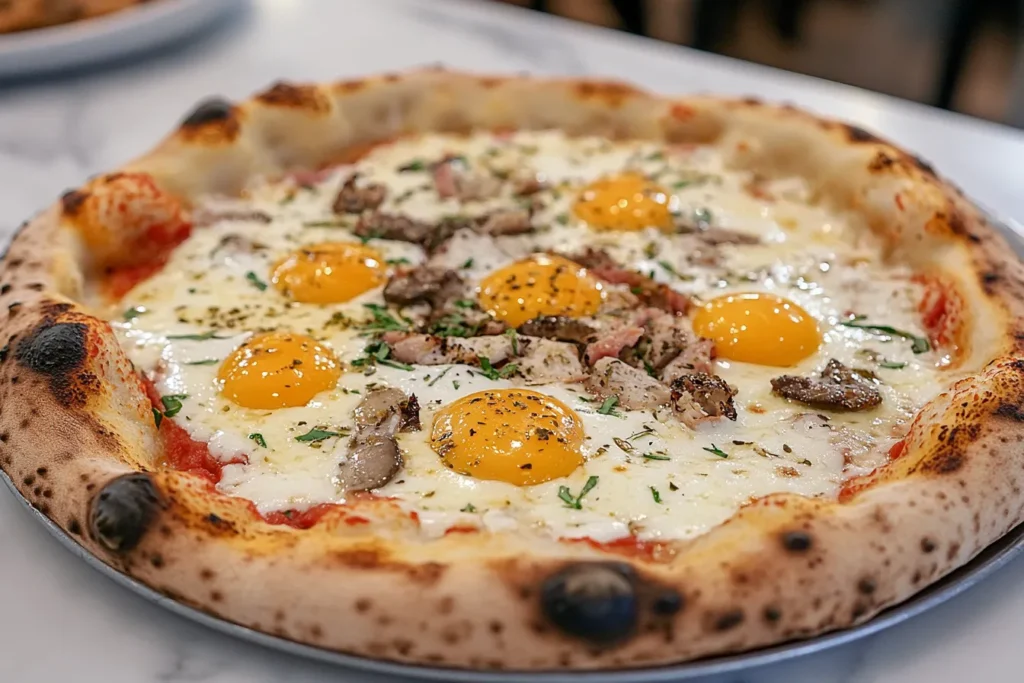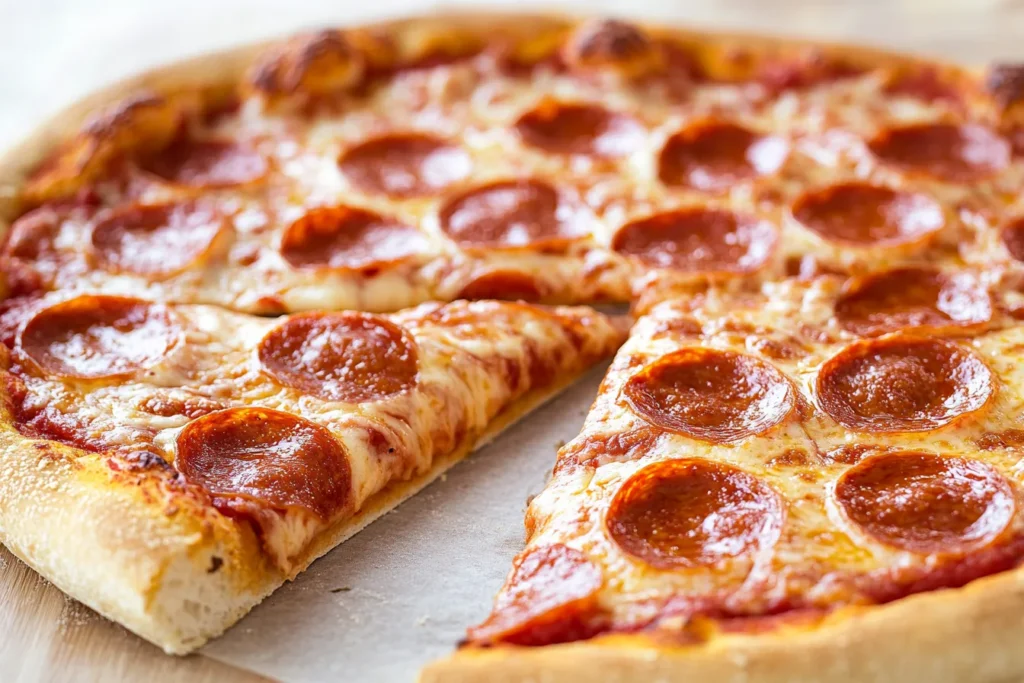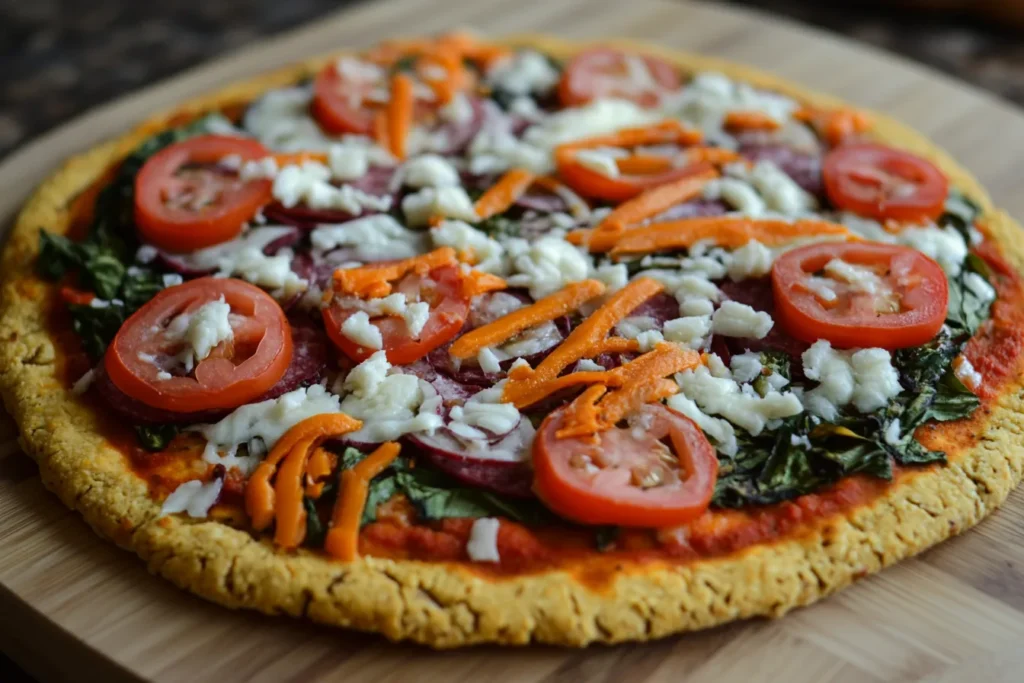Imagine craving a delicious, cheesy pizza, but the thought of gluten makes you pause. Sound familiar? You’re not alone. For many, enjoying pizza can feel like a compromise—settling for options that don’t quite hit the mark or skipping it altogether. But what if I told you that gluten-free pizza doesn’t have to mean sacrificing flavor or texture? Whether you’re managing celiac disease, gluten sensitivity, or simply exploring healthier choices, this guide will show you how to create or find gluten-free pizza that satisfies every craving. Let’s dive into a world of doughy delights designed just for you!
List Of Contents
Introduction to Gluten-Free Pizza
Pizza has long been a universal favorite; however, for individuals with gluten sensitivities or celiac disease, enjoying this beloved dish can be particularly tricky. Consequently, the rise of gluten-free alternatives has become a game-changer, offering a delicious solution for those previously unable to indulge. Gluten-free pizza is a solution tailored for those seeking to avoid gluten, a protein found in wheat, barley, and rye. check out more recipes here.

What is Gluten?
- Gluten is a structural protein that provides elasticity to dough.
- Found in grains like wheat, rye, and barley, gluten gives pizza crust its chewy texture.
Why Choose Gluten-Free Pizza?
- Gluten-free pizza is essential for individuals with celiac disease or non-celiac gluten sensitivity, as it allows them to enjoy pizza without compromising their health. Furthermore, it offers a valuable alternative for health-conscious individuals who choose to avoid gluten in order to reduce inflammation or improve digestion. Additionally, gluten-free pizza often incorporates healthier, nutrient-rich ingredients, making it a preferred choice even for those without specific dietary restrictions. Check out more recipes here.
History of Gluten-Free Pizza
The concept of gluten-free pizza didn’t emerge overnight. The evolution of dietary trends and the growing need for inclusive options played a vital role.
Evolution of Pizza for Special Diets
- Traditional pizza originated in Italy, but its versatility has led to endless variations worldwide.
- Over the decades, the rise in dietary restrictions prompted the need for alternatives, such as gluten-free, vegan, and keto pizzas.
Rise in Gluten-Free Food Trends
- The global gluten-free market is projected to exceed $8 billion by 2025, which clearly reflects the surging demand for gluten-free alternatives. As a result, restaurants and food brands are rapidly adapting to this growing trend by offering an increasingly diverse range of gluten-free options to meet customer needs and preferences. Check out more recipes here.
Health Benefits of Gluten-Free Pizza
Who Benefits from Gluten-Free Diets?
- Celiac disease patients: Gluten-free pizza is crucial for avoiding severe autoimmune reactions.
- People with non-celiac gluten sensitivity: Gluten-free options reduce bloating, fatigue, and other symptoms.
- Health enthusiasts: Many choose gluten-free diets for potential health benefits, such as better digestion and reduced inflammation.
Common Myths About Gluten-Free Foods
- Myth: Gluten-free foods are always healthier.
- Fact: While gluten-free pizza can be nutrient-rich, some options are high in sugar or fat.
- Myth: Only those with celiac disease need gluten-free products.
- Fact: Many people benefit from gluten-free diets for improved digestion.
Key Ingredients in Gluten-Free Pizza Dough
Crafting the perfect gluten-free pizza crust starts with the right ingredients.
Gluten-Free Flour Options
- Almond flour: High in protein and low in carbs.
- Rice flour: A versatile option with a neutral flavor.
- Tapioca flour: Adds elasticity and chewiness to the dough.
Binding Agents
Since gluten is absent, binding agents ensure the dough holds together:
- Xanthan gum: Provides elasticity similar to gluten.
- Psyllium husk: A fiber-rich binding agent that enhances texture.
Preparing Gluten-Free Pizza Dough
Homemade gluten-free pizza dough may seem daunting, but it’s easier than you think.
Step-by-Step Recipe for Beginners
- Combine 2 cups of gluten-free flour, 1 tsp of xanthan gum, and 1 tsp of salt.
- Add 1 cup of warm water, 1 packet of yeast, and 1 tbsp of olive oil.
- Mix until a sticky dough forms.
- Let it rest for 30 minutes before rolling it out.
Tips for a Perfect Texture
- Place the dough between sheets of parchment paper to prevent sticking while rolling it out.
- Pre-bake the crust for 5-7 minutes to avoid sogginess.
Gluten-Free Pizza Crust Variations
Thin Crust, Deep Dish, and Flatbread
- Thin crust: Perfect for a crispy, cracker-like base.
- Deep dish: Achieved by using extra xanthan gum for added structure.
- Flatbread: Ideal for quick, casual meals.
Alternative Bases
- Cauliflower crust: Low-carb and nutrient-dense.
- Sweet Potato Crust: Naturally flavorful, sweet, and packed with fiber.
Selecting Gluten-Free Pizza Toppings

Meat, Vegetables, and Cheeses
- Proteins: Grilled chicken, pepperoni, or bacon.
- Veggies: Spinach, bell peppers, mushrooms, and artichokes.
- Cheeses: Mozzarella, parmesan, or dairy-free alternatives.
Hidden Sources of Gluten in Toppings
- Beware of gluten in:
- Pre-marinated meats.
- Sauces like BBQ or soy sauce.
- Processed toppings, such as imitation crab meat.
Gluten-Free Pizza Sauce Options
Tomato-Based Sauces
- Opt for plain tomato sauce or marinara free of additives.
Pesto and Cream-Based Alternatives
- Pesto: A nutty, herby sauce that pairs well with vegetarian pizzas.
- Dairy-free cream sauces: Made with cashews or coconut milk.
Baking Techniques for Gluten-Free Pizza
Best Practices for Oven and Grill Baking
- Oven: Preheat to 425°F and use a pizza stone for even heat distribution.
- Grill: Use a grill-safe pan and cook on medium heat for a smoky flavor.
Common Mistakes to Avoid
- Overloading toppings: Leads to a soggy crust.
- Baking at low temperatures: Results in an undercooked base.
Gluten-Free Pizza for Different Diets
Dairy-Free and Vegan Options
- Use nut-based cheeses and plant-based meats.
Low-Carb and Keto-Friendly Recipes
- Opt for cauliflower or almond flour crusts to keep carbs in check.
Ready-Made Gluten-Free Pizza Crusts
For those with hectic schedules, store-bought gluten-free pizza crusts provide a convenient option without sacrificing flavor. Check out more recipes here.
Best Store-Bought Brands
- Udi’s Gluten-Free: Known for its thin and crispy crust.
- Caulipower: A cauliflower-based crust with a mild flavor and sturdy texture.
- Bob’s Red Mill Mix: A versatile gluten-free pizza dough mix.
Evaluating Ingredients and Taste
- Check for allergen-friendly labels.
- Choose crusts made with natural ingredients such as rice flour or almond flour.
- Avoid brands with excessive starches or artificial preservatives.
Gluten-Free Pizza in Restaurants
Dining out can be tricky for gluten-free eaters, but many restaurants now offer options to accommodate their needs.
Top Restaurants Offering Gluten-Free Options
- California Pizza Kitchen: Offers certified gluten-free crusts.
- MOD Pizza: Allows full customization with gluten-free bases.
- Blaze Pizza: Known for its fast-fired pizzas and safe gluten-free practices.
How to Ensure Your Order is Safe
- Confirm with the staff about cross-contamination protocols.
- Ask if gluten-free pizzas are prepared with separate utensils and on clean surfaces.
Kid-Friendly Gluten-Free Pizza Recipes
Keeping kids entertained and nourished can be a balancing act, but gluten-free pizza is a crowd-pleaser. Check out more recipes here.
Fun Shapes and Sizes for Kids
- Use cookie cutters to create star- or heart-shaped mini pizzas.
- Personal-sized pizzas let kids pick their favorite toppings.
Sweet Pizza Ideas (Dessert Pizzas)
- Base: Use almond flour dough for a slightly sweet crust.
- Toppings: Nutella, fresh fruit, or whipped cream.
- For a dairy-free option, consider coconut yogurt and dark chocolate shavings.
Customizing Gluten-Free Pizza Recipes
Experimenting with Regional Flavors
- Margherita: Stick to classic Italian ingredients like fresh basil, mozzarella, and tomatoes.
- Mexican-Inspired: Add black beans, salsa, and avocado.
- Mediterranean: Try feta, olives, and roasted red peppers.
Popular International Gluten-Free Pizzas
- Indian Naan Pizza: Use gluten-free naan with curry-flavored toppings.
- Japanese Okonomiyaki Pizza: A rice flour base topped with cabbage, shrimp, and a drizzle of Japanese mayo.
Challenges of Gluten-Free Pizza Making
Making gluten-free pizza at home can be tricky, but understanding the common challenges helps you perfect the craft.
Managing Sticky Dough
- Use extra rice flour or tapioca flour to dust your surface while rolling.
- Chill the dough for 15–20 minutes to make it easier to handle.
Avoiding a Dense or Dry Crust
- Add olive oil to improve moisture retention.
- Use sparkling water or yogurt for a lighter texture.
Gluten Free vs. Traditional Pizza
- Gluten-free crusts are often lower in calories but may lack the protein content of traditional wheat-based crusts.
- Traditional crusts contain gluten, which provides a more elastic texture but is a problem for sensitive individuals.
Calorie and Nutrient Breakdown
- Almond flour crust: High in protein and healthy fats but calorie-dense.
- Cauliflower crust: Low-calorie and nutrient-rich, ideal for weight-conscious individuals.
Gluten-Free Pizza for Special Occasions
Whether it’s a birthday or a festive gathering, gluten free pizza can steal the show.

Party-Ready Recipes
- Buffalo Chicken Pizza: Use a gluten free crust topped with spicy buffalo sauce, grilled chicken, and ranch dressing.
- BBQ Pulled Pork Pizza: A smoky treat for meat lovers.
Seasonal Toppings and Themes
- Autumn: Butternut squash, sage, and caramelized onions.
- Summer: Fresh basil, heirloom tomatoes, and zucchini.
Storing Gluten Free Pizza
Tips for Freezing Dough and Cooked Pizzas
- Wrap dough tightly in plastic wrap before freezing.
- Pre-bake crusts and store them in freezer-safe bags for quick assembly later.
Reheating Methods for Best Results
- You can regain crispiness by reheating using either an oven or an air fryer.
- Avoid microwaving, as it may make the crust rubbery.
Budget-Friendly Gluten Free Pizza
Cost-Effective Ingredient Substitutions
- To make gluten-free pizza more economical, swap almond flour for oat flour, an affordable alternative that maintains great taste and texture. Alternatively, create a cost-effective crust by using homemade cauliflower rice, which is both low-carb and nutritious.
Making Gluten Free Pizza on a Budget
- To save money while making gluten-free pizza, consider buying ingredients like tapioca flour or psyllium husk in bulk, as this can significantly reduce overall costs. Additionally, opting for seasonal vegetables as toppings not only cuts expenses but also ensures fresh, flavorful, and nutrient-rich additions to your pizza.
Gluten Free Pizza Around the World
Italian Gluten-Free Innovations
- Italian pizzerias have now embraced gluten-free bases, offering options that closely rival the taste and texture of traditional crusts. For example, polenta pizza, a naturally gluten free alternative, is gaining significant popularity in Italy, further showcasing the creativity and inclusivity of modern Italian cuisine.
Unique Regional Recipes
- Brazilian Cheese Pizza: Tapioca-based crust topped with cheese and olives.
- Middle Eastern Flatbread: A gluten-free crust topped with za’atar seasoning and creamy labneh for a flavorful twist.
Gluten Free Pizza Success Stories
Real-life experiences with gluten free pizza can be incredibly inspiring for both home chefs and restaurateurs, as they highlight the creativity and adaptability required to craft delicious gluten free options. These stories frequently highlight the successes, challenges, and innovations that shape the ongoing evolution of gluten-free cooking. By showcasing creative solutions and personal triumphs, they inspire others to explore and embrace this growing culinary niche, encouraging both novice and seasoned chefs to experiment with gluten-free recipes and techniques.
Stories from Home Chefs
- Anna from Chicago embraced gluten-free baking after her child was diagnosed with celiac disease, transforming her kitchen to meet their dietary needs. She mastered almond flour crusts and now shares her recipes through a successful blog.
- Tom in Austin: Experimented with cauliflower crusts to create low-carb options, earning him a dedicated following on social media.
Restaurant Owners Who Switched to Gluten-Free
- A pizzeria in Portland began offering gluten-free options due to customer demand and now reports a 30% increase in sales.
- An Italian restaurant in New York City uses rice and quinoa flour to replicate traditional crusts, garnering rave reviews.
Expert Tips and Tricks
Enhancing Flavor Without Gluten
- Add herbs like oregano, thyme, and rosemary directly to the dough.
- Brush the crust with garlic-infused olive oil before baking for a burst of flavor.
Perfecting Dough Consistency
- Combine flours like almond and tapioca to create a perfect balance of structure and softness in your recipes.
- Hydrate the dough adequately to prevent dryness.
Gluten-Free Pizza and Celiac Disease
Why It’s a Necessity for Celiac Patients
Celiac disease is a severe autoimmune condition where consuming gluten harms the small intestine, potentially causing multiple health issues. As a result, gluten-free pizza offers a safe and tasty alternative, allowing individuals with celiac disease to savor their favorite dish without risking their health.
Cross-Contamination Precautions
- To prevent cross-contamination, it is essential to use dedicated utensils, baking sheets, and mixers exclusively for gluten-free cooking. Additionally, storing gluten-free ingredients separately from other baking supplies ensures they remain uncontaminated, maintaining their safety for individuals with gluten sensitivities or celiac disease.
Gluten-Free Pizza on the Go
Best Pre-Packaged Options
- Amy’s Gluten-Free Margherita Pizza: Ready-to-bake and made with organic ingredients.
- Glutino Spinach & Feta Pizza: A savory option for quick meals.
Travel Tips for Finding Gluten-Free Pizza
- Use apps like Find Me Gluten Free to locate restaurants that cater to gluten-free diets.
- Research local gluten-free bakeries or pizzerias before traveling.
Gluten-Free Pizza in the Food Industry
Growth of Gluten-Free Products
- The gluten-free market has expanded significantly, with pizza being one of the most in-demand products.
- Major pizza chains like Domino’s and Pizza Hut now offer gluten-free options.
Consumer Trends in Pizza Consumption
- Millennials are increasingly driving the demand for healthier and gluten-free alternatives, as they prioritize wellness and dietary inclusivity. Moreover, the rise of home delivery services has made gluten-free pizza more accessible than ever, ensuring convenience for consumers seeking these specialized options..
Innovations in Gluten-Free Pizza
Emerging Techniques in Dough Preparation
- Fermentation: Using fermented flours to enhance flavor and digestibility.
- New Binding Agents: Chia seeds and flaxseed meal are gaining traction as natural alternatives to xanthan gum.
New Gluten-Free Ingredients
- Teff flour, a nutrient-rich grain, is rapidly gaining popularity in gluten-free baking due to its high protein, fiber, and mineral content, making it a wholesome alternative to traditional flours. Additionally, incorporating plant-based proteins into dough not only boosts its nutritional value but also caters to health-conscious individuals and those following plant-based diets, enhancing the versatility of gluten-free pizza.
Pairing Gluten-Free Pizza with Drinks
Wine and Beer Pairings
- Light-bodied white wines, like Sauvignon Blanc, complement veggie pizzas.
- Gluten-free beers, such as Redbridge or Omission, pair well with hearty meat toppings.
Non-Alcoholic Beverage Options
- Refreshing beverage options like sparkling water with a splash of citrus provide a crisp, light pairing for gluten-free pizza. Similarly, iced herbal teas, such as chamomile or mint, offer a soothing and flavorful alternative that complements the dish while catering to diverse taste preferences.
Feedback from Gluten-Free Communities
Insights from Celiac and Gluten-Intolerant Consumers
- Many individuals express immense gratitude for the increasing availability of gluten-free options, as it allows them to enjoy a wider variety of foods without compromising their dietary needs. However, common feedback often emphasizes the need for improvements in texture and taste, particularly in pre-made crusts, which remain a crucial area for innovation and development in the gluten-free market.
Favorite Recipes and Ingredients
- Homemade cauliflower crusts topped with pesto and fresh veggies.
- Rice flour crusts with a traditional Margherita topping.
Conclusion: The Future of Gluten-Free Pizza
Sustainability in Gluten-Free Ingredients
- The shift toward sustainable farming of gluten-free grains, such as millet and quinoa, is highly promising for both the environment and the gluten-free food industry. Additionally, innovative packaging solutions are playing a key role in reducing waste, further enhancing the sustainability and appeal of gluten-free products for eco-conscious consumers.
Predictions for Gluten-Free Pizza Trends
There is an increased focus on enhancing the flavor and texture of pre-made gluten-free crusts, addressing a critical aspect of consumer satisfaction. Furthermore, the greater integration of gluten-free pizza into mainstream dining experiences has made it more accessible and widely appreciated. As a result, gluten-free pizza has evolved from a niche product into a mainstream favorite, offering endless possibilities for creativity, flavor, and inclusivity, appealing to a broad range of dietary needs and preferences.
FAQs
- Is gluten free pizza healthier than regular pizza?
- It depends on the ingredients. Gluten free pizza can be lower in calories and carbs, but some store-bought crusts may contain high amounts of sugar and fat.
- Why is my gluten free pizza crust so crumbly?
- Lack of binding agents like xanthan gum or psyllium husk can cause crumbliness.
- Can I use gluten-free all-purpose flour for pizza?
- Yes, but check if the blend includes binding agents for elasticity.
- Does gluten-free pizza taste different?
- The flavor is slightly different, depending on the flour used. Almond and coconut flour impart a nutty flavor, while rice flour is neutral.
- Is gluten-free pizza safe for people with celiac disease?
- As long as it’s prepared in a gluten-free environment to prevent cross-contamination.
- What’s the best gluten-free flour for pizza dough?
- A mix of almond, tapioca, and rice flours works best for structure and flavor.
- Can gluten-free pizza be frozen?
- Yes, both the dough and pre-baked crusts freeze well.
- Why is my gluten-free crust soggy?
- Overloading toppings or underbaking the pizza are common mistakes that can lead to a soggy crust. To achieve better results, it’s recommended to pre-bake the crust for a few minutes before adding toppings, ensuring a firmer base and a more evenly baked pizza.
- Are there gluten-free vegan pizzas?
- Absolutely! You can create delicious vegan and gluten-free pizzas by using gluten-free crusts paired with vegan cheeses and a variety of plant-based toppings such as roasted vegetables, fresh herbs, and dairy-free sauces. This combination ensures a flavorful and inclusive option for those with dietary restrictions.
- How do I avoid a dense crust?
- Add carbonated water or yogurt to the dough for a lighter texture.
